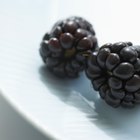
-lvinst-/iStock/Getty Images
Dietary fiber is the part of plant foods that your body cannot break down. It has numerous benefits on your body, including maintaining your digestive health, reducing your blood cholesterol and maintaining your blood sugar levels. Women need 25 g of fiber each day, but men need up to 38 g, reports MayoClinic.com. Spread your high-fiber food portions out throughout the day to avoid bloating, gas, constipation and diarrhea.
Fruits
Fruits are high in soluble fiber, which attracts water and forms a gel in your digestive tract. Soluble fiber can help reduce the "bad" LDL cholesterol in your body, and may lower your blood pressure. For maximum fiber consumption from fruits, eat the edible skin on apples, pears and other similar fruits. A 2.5 cup serving of raspberries, blackberries or blueberries provide 20 g of fiber. You can also enjoy four medium pears or apples, three large bananas or 1 1/4 cups of dried figs or dates. Each of these fruit servings provide 20 g of fiber.
Vegetables
Most non-starchy vegetables are high in insoluble fiber. This type of fiber stays intact in your gut and moves food through your intestines, helping to relieve constipation and keep you regular. Artichokes are very high in fiber -- just two medium artichokes provide 20 grams. You may also enjoy 4 cups of steamed broccoli, 5 cups of cooked Brussels sprouts, five large carrots or 3.5 cups of raw spinach. Starchy vegetables have higher amounts of soluble fiber. Eat 4.5 cups of cooked corn or 2.5 cups of peas. All of these veggie servings provide around 20 g of dietary fiber.
Beans and Lentils
Beans and lentils are loaded with protein and soluble fiber, reports MayoClinic.com. A 1 1/3 cup serving of cooked green lentils contains 20 g of fiber. You may also like 1 1/3 cups of black beans, 1.5 cups of lima beans, 2 cups of vegetarian baked beans or 1 1/4 cup of split peas. Each of these servings contain 20 g of fiber.
Grain Foods
Whole grain foods are excellent sources of both soluble and insoluble fiber. Both types are equally important in your diet. Five slices of cracked wheat bread contains 20 g of fiber, as well as four slices of dark rye. Cook whole grains and mix them in your tossed salad, or enjoy them hot, as a side to your entree. You can get 20 g of fiber from 2 cups of bulgur wheat or buckwheat. High-bran cereals can have as much as 20 g of fiber per cup.
Related Articles

2500 Calorie Menu

List of High Protein Vegetables

Nutrition Information on Blueberries

Free Meal Plans Between 1300 & 1400 ...

How Many Calories Are In a Chicken & ...

High Fiber & Protein Diet Menus

Avocado Serving Size & Nutrition

Top Vegetables With Selenium

Types of Fruit Smoothies

How Much Whole Grain Should You Eat a ...

The Nutritional Value of Edamame Beans
The Calories in Seafood Paella

The Function of Fruits

Menus for Toddlers & Five-Year-Olds for ...

Foods to Avoid to Prevent Gout
Low-Protein Breakfast Menu

How to Clean Out Your Stomach With ...

How to Cook Soybeans in a Microwave
Calories in a Cucumber and Avocado Roll

Can You Change Skin Tone with Food?
References
Writer Bio
Melodie Anne Coffman specializes in overall wellness, with particular interests in women's health and personal defense. She holds a master's degree in food science and human nutrition and is a certified instructor through the NRA. Coffman is pursuing her personal trainer certification in 2015.
Photo Credits
-lvinst-/iStock/Getty Images